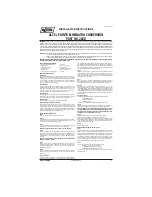
CRADLEPOINT
COR | USER MANUAL Firmware ver. 5.0.0
© 2013
CRADLEPOINT, INC. PLEASE VISIT
HTTP://KNOWLEDGEBASE.CRADLEPOINT.COM/
FOR MORE HELP AND RESOURCES
PAGE 130
7.1.5
IPv6 Settings
The IPv6 (
http://en.wikipedia.org/wiki/IPv6
) configuration allows you to enable and configure IPv6 for a WAN device.
These settings should be configured in combination with the IPv6 LAN settings (go to
Network Settings
→
WiFi / Local
Networks
, select the LAN under
Local IP Networks
, and click
Edit
) to achieve the desired result.
This is a dual-stacked implementation of IPv6, so IPv6 and IPv4 are used alongside each other. If you enable IPv6, the
router will not allow connections via IPv4. When IPv6 is enabled, some router features are no longer supported. These
are:
•
RADIUS/ accounting for wireless clients and admin/CLI login
•
IP Passthrough (not needed with IPv6)
•
NAT (not needed with IPv6)
•
Bounce pages
•
UPnP
•
Network Mobility
•
DHCP Relay
•
VRRP, GRE, GRE over IPSec, OSPF, NHRP
•
Syslog
•
SNMP over the WAN (LAN works)
There are two main types of IPv6 WAN connectivity: native (
Auto
and
Static
) and tunneling over IPv4 (
6to4
,
6in4
, and
6rd
).
•
Native
– (
Auto
and
Static
) The upstream ISP routes IPv6 packets directly.
•
IPv6 tunneling
– (
6to4
,
6in4
, and
6rd
) Each IPv6 packet is encapsulated by the router in an IPv4 packet and
routed over an IPv4 route to a tunnel endpoint that decapsulates it and routes the IPv6 packet natively. The reply is
encapsulated by the tunnel endpoint in an IPv4 packet and routed back over an IPv4 route. Some tunnel modes do
not require upstream ISPs to route or even be aware of IPv6 traffic at all. Some modes are utilized by upstream
ISPs to simplify the configuration and rollout of IPv6.
Summary of Contents for COR IBR600
Page 1: ......
















































